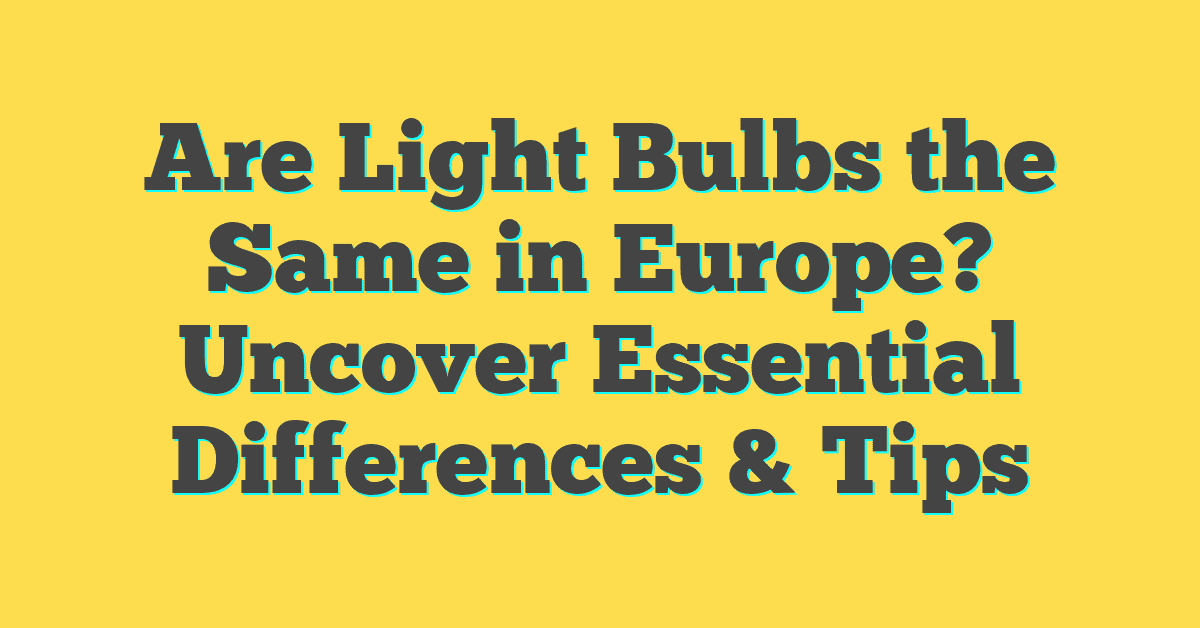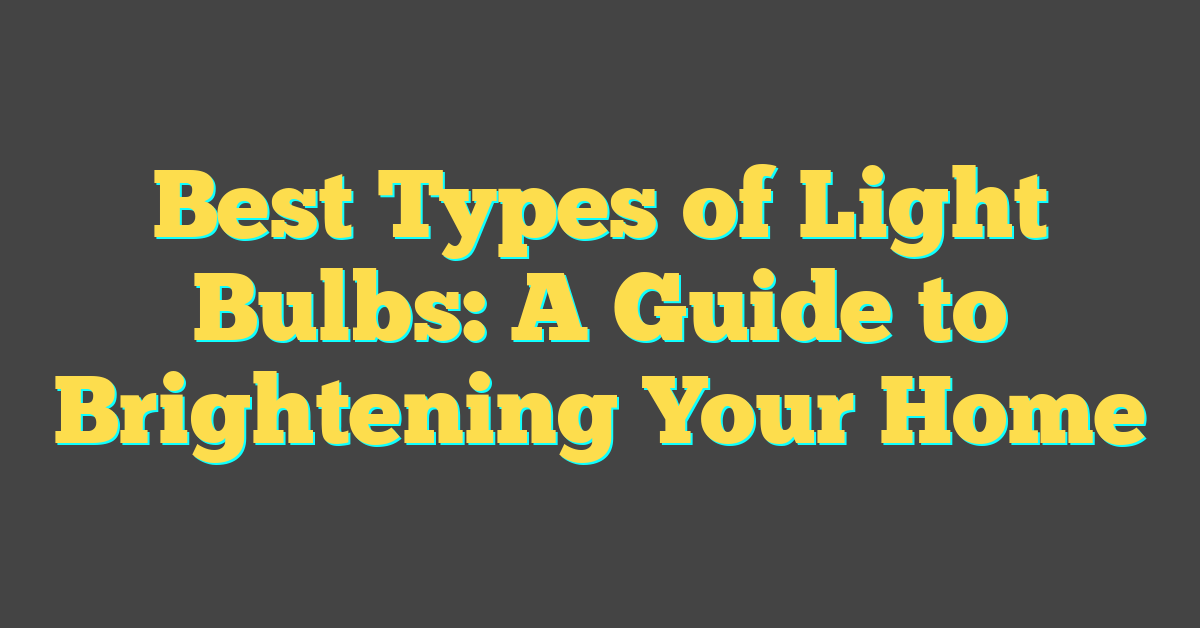Ever wondered why the glow from your bedside lamp is often a warm, yellow hue rather than stark white? It’s not just about aesthetics; there’s some fascinating science behind it. You’re about to find out why light bulbs often give off that cozy, yellow light that makes your home feel like a snug haven.

The yellow tint in light bulbs isn’t just a random choice by manufacturers. It’s a carefully considered decision that impacts everything from your mood to your sleep cycle. Stick around and you’ll discover the reasons behind this illuminating subject.
The Science Behind Light Bulb Colors
When you’re browsing the lighting aisle, it’s clear that not all light bulbs are created equal. Color temperature is a key term in the lighting industry that explains the spectrum of light emitted by a bulb. This is measured in Kelvin (K) and can range from a low, warm orange glow at around 1,700K to a blue-sky daylight at 6,500K or higher.
Let’s break it down:
- Warm White (below 3,000K): Emits a cozy, calm light that’s ideal for bedrooms and living spaces.
- Cool White (3,000K to 4,500K): Provides a more neutral, crisp light suitable for kitchens and bathrooms.
- Daylight (above 4,500K): Offers a vibrant, energetic light mirroring natural daylight, perfect for task lighting and workspaces.
Your favorite yellow-tinted bulbs fall into the warm white category. The reason for this warmth is rooted in the science of how our eyes perceive light. At the lower end of the Kelvin scale, there’s a dominance of reds and yellows, which our brains associate with sunset hours—times of rest and relaxation.
Here’s an interesting tidbit: the lighting industry got its start with incandescent bulbs, which naturally give off a warm glow. So, in some ways, the prevalence of yellow light is a nod to tradition but it’s also about biology. Modern bulbs have options for variable color temperatures which means you can choose the warmth or coolness of the light based on your task or mood.
Moreover, the phosphors inside fluorescent bulbs and the diodes in LED lights are tweaked to emit specific color temperatures. This is achieved by altering the material composition within the bulb, which in turn affects the color of the light produced.
Whether you’re planning to set a relaxing atmosphere in your reading nook or needing to focus on your latest DIY project, understanding the color temperatures of your light bulbs can make all the difference. Remember, lighting isn’t just about visibility; it’s about creating the right ambiance for every corner of your home.
Understanding the Color Temperature Scale

Dive into the world of color temperatures, and you’ll find it’s not as complicated as it first seems. Think of the color temperature scale as a way to measure the hue of the light a bulb emits, not how hot it is. It’s crucial to get it right—after all, the color of light can make or break the comfort of your space.
Measured in Kelvin (K), color temperatures on the scale range from about 1,500K to 10,000K. The lower end of the spectrum features your cozier, amber lights—those are your traditional yellow bulbs. As you climb higher in Kelvin, you reach the midday sunlight effect, which is much bluer in tone.
Here’s a simple breakdown:
- Warm White: Ranging from about 2,200K to 3,000K, these bulbs create a welcoming atmosphere. They’re perfect for your living rooms or bedrooms where you want to unwind and relax.
- Cool White: Sitting between about 3,000K and 4,500K, these bulbs offer a more neutral white light. Your kitchen and bathroom will benefit from this crisper illumination.
- Daylight: At 4,500K and above, the light is invigorating and great for concentration and task-focused areas like your home office or garage.
Why is there such a range, you ask? It’s because different activities and times of day require different types of lighting. Imagine trying to chill out in your snug reading nook under the harsh glare of a high-Kelvin bulb—not the mood you’re aiming for!
As a lighting aficionado, you’ll love experimenting with these temperatures around your home. You could blend them to achieve just the right balance; a cooler light for intricate DIY projects and a warmer one for that dinner party you’ve been planning. It’s about creating an ambiance that resonates with your personal aesthetic and functional needs.
Light bulbs are not just commodities; they’re tools that allow you to paint your home with light. With a bit of knowledge about the color temperature scale, you’re well on your way to tailoring your living spaces to perfection. And let’s be honest, lighting is the unsung hero of home design—it can completely transform a room without a single stroke of paint or a piece of furniture moved.
Why Light Bulbs Emit Yellow Light
« Do Light Bulbs Have Resistance? Unlock the Shocking Truth
What Light Bulbs Are Made in the USA? Discover Top Brands for Your Home »

Ever wondered why some light bulbs give off a cozy yellow glow? The answer lies in the science of color temperature and sometimes, the bulb’s purpose. Typically, yellow light, with its warm appearance, is attributed to light bulbs designed for comfort and relaxation.
When you’re developing a DIY lighting solution for your home, understanding the yellow light’s role can be crucial. The yellow or soft light is often associated with warm white ranges of 2700K to 3000K on the Kelvin scale. This range is preferred for areas where you want to create a snug and inviting atmosphere.
This soothing yellow light is the result of light bulbs with a lower color temperature. Such bulbs mimic the warm hues found in natural elements like candlelight or the golden hours of sunrise and sunset. And as a lighting aficionado, you’ll know that these are the moments when the world feels calm and serene.
There’s an interesting fact about yellow light that isn’t widely known. Yellow light is not just for aesthetic and ambience; it’s believed to have a less intrusive impact on our circadian rhythms. This aspect is especially important if you’re keen on keeping your sleep cycle consistent. Lighting in the yellow spectrum can help you unwind at the end of the day, signaling your body that it’s time to rest.
In your search for the perfect lighting, you’ll encounter bulbs labeled as “soft white” or “warm white.” These are your go-to options for that coveted yellow light. They’re fantastic for living rooms, dens, and bedrooms, where the main activities include lounging, reading, or preparing for sleep.
Remember, lighting isn’t just functional; it’s an integral part of your home’s design. It shapes the way spaces feel and how they’re used. Incorporating yellow light through strategic bulb selection is just one more tool in your arsenal to create the perfect home environment.
Impact on Mood and Sleep Cycle

Ever wondered why you feel more relaxed in rooms with a warm, yellow glow? It’s not just your imagination; color temperature significantly affects your mood. Yellow light, often associated with sunset hues, tends to make you feel calmer and more at peace. This is because warmer light can decrease cortisol levels, which are linked to stress.
Light also plays a vital role in regulating your circadian rhythm, your body’s internal clock. The soft warm white light, falling in the 2700K – 3000K range, can signal your body that it’s time to wind down. This range mimics the end of the day light, which is crucial in preparing your body for sleep. In contrast, cooler light that mimics midday sunlight is better for keeping you alert and enhancing concentration.
Here’s an interesting bit to keep in mind:
- At night, exposure to blue light, which is prevalent in daylight bulbs (>5000K), can interrupt the production of melatonin, the sleep-inducing hormone.
- Warm yellow light does not have this effect and thus promotes better sleep patterns.
When selecting light bulbs for your bedroom or evening relaxation spaces, consider bulbs labeled as “soft white” or “warm white.” They not only create a cozy ambiance but also encourage a more restful night’s sleep. It’s a simple change, but swapping out that stark, bright white bulb on your bedside table for something a little warmer could make all the difference in your sleep quality.
In addition to the direct impact on sleep, the ambiance created by yellow light can play into your broader emotional well-being. A well-lit room with a warm glow can be an inviting space to settle down with a book, spend time with your loved ones, or indulge in your favorite DIY home projects. The right lighting sets the tone for these activities, making the environment as comforting and enjoyable as possible.
Conclusion
You’ve seen how the warm yellow glow of a light bulb isn’t just for aesthetics—it’s about creating a space where you can relax and feel at ease. By choosing the right color temperature for your bulbs, you’re tailoring your environment to suit your needs, whether that’s winding down at night or staying alert and focused during the day. Remember, soft white bulbs are your go-to for that cozy, comforting atmosphere that helps you unwind. So next time you’re bulb shopping, think about the mood you want to set in each room. With this insight, you’re ready to light up your home in a way that’s not only smart but also good for your well-being.
Frequently Asked Questions
What is color temperature in light bulbs?
Color temperature in light bulbs refers to the hue of the light emitted, measured in Kelvin (K). It ranges from a warm orange glow (lower Kelvin) to blue-sky daylight (higher Kelvin).
How does color temperature affect the ambiance of a room?
Color temperature can significantly influence the ambiance of a room, with warm white creating a cozy atmosphere ideal for bedrooms, while cool white and daylight provide brighter illumination suitable for kitchens, bathrooms, and workspaces.
What color temperature is best for relaxation and sleep?
Soft warm white light in the 2700K – 3000K range is best for relaxation and sleep as it helps decrease cortisol levels and signals the body to wind down, promoting better sleep patterns.
Can blending different color temperatures create a better ambiance?
Yes, blending different color temperatures in lighting can create a more layered and dynamic ambiance, suitable for various activities and times of day in your home.
How does warm yellow light affect mood and sleep?
Warm yellow light has a calming effect that can improve emotional well-being and contribute to a comforting environment. It can also reduce cortisol levels, aiding in relaxation and better sleep.




